Zhedong Zhang
FlowDubber: Movie Dubbing with LLM-based Semantic-aware Learning and Flow Matching based Voice Enhancing
May 02, 2025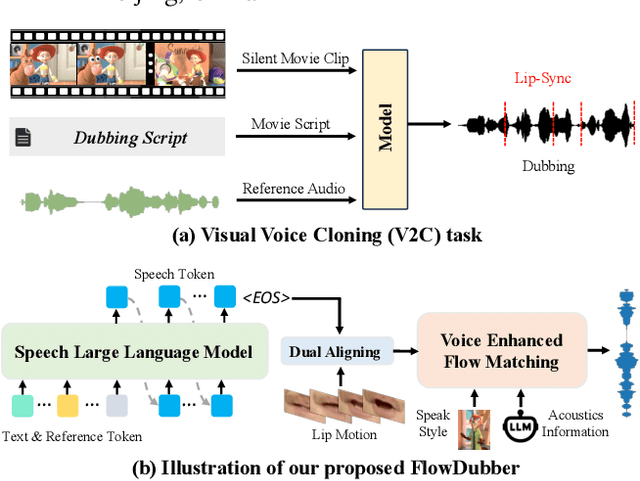

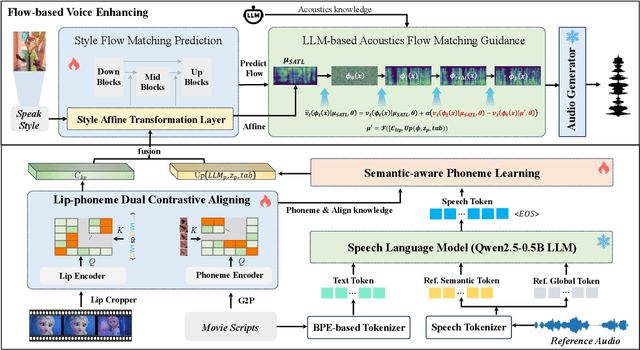

Abstract:Movie Dubbing aims to convert scripts into speeches that align with the given movie clip in both temporal and emotional aspects while preserving the vocal timbre of a given brief reference audio. Existing methods focus primarily on reducing the word error rate while ignoring the importance of lip-sync and acoustic quality. To address these issues, we propose a large language model (LLM) based flow matching architecture for dubbing, named FlowDubber, which achieves high-quality audio-visual sync and pronunciation by incorporating a large speech language model and dual contrastive aligning while achieving better acoustic quality via the proposed voice-enhanced flow matching than previous works. First, we introduce Qwen2.5 as the backbone of LLM to learn the in-context sequence from movie scripts and reference audio. Then, the proposed semantic-aware learning focuses on capturing LLM semantic knowledge at the phoneme level. Next, dual contrastive aligning (DCA) boosts mutual alignment with lip movement, reducing ambiguities where similar phonemes might be confused. Finally, the proposed Flow-based Voice Enhancing (FVE) improves acoustic quality in two aspects, which introduces an LLM-based acoustics flow matching guidance to strengthen clarity and uses affine style prior to enhance identity when recovering noise into mel-spectrograms via gradient vector field prediction. Extensive experiments demonstrate that our method outperforms several state-of-the-art methods on two primary benchmarks. The demos are available at {\href{https://galaxycong.github.io/LLM-Flow-Dubber/}{\textcolor{red}{https://galaxycong.github.io/LLM-Flow-Dubber/}}}.
Prosody-Enhanced Acoustic Pre-training and Acoustic-Disentangled Prosody Adapting for Movie Dubbing
Mar 15, 2025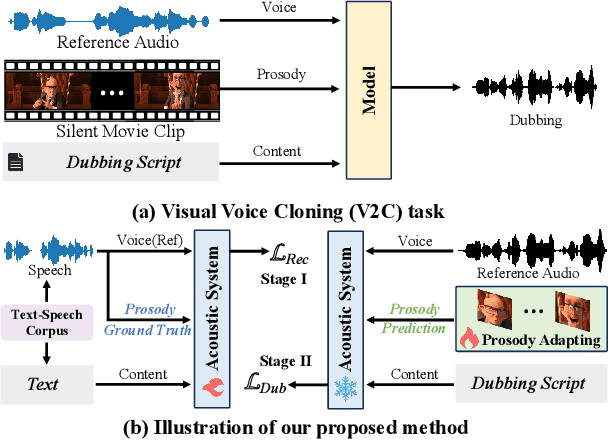

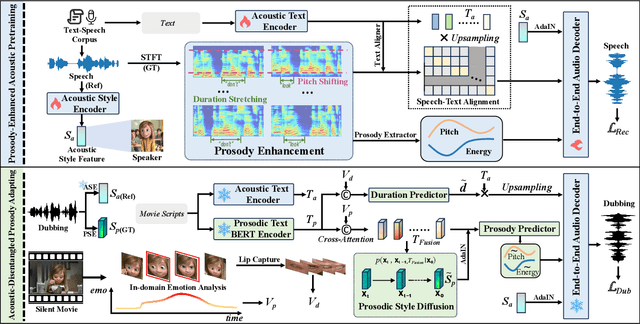

Abstract:Movie dubbing describes the process of transforming a script into speech that aligns temporally and emotionally with a given movie clip while exemplifying the speaker's voice demonstrated in a short reference audio clip. This task demands the model bridge character performances and complicated prosody structures to build a high-quality video-synchronized dubbing track. The limited scale of movie dubbing datasets, along with the background noise inherent in audio data, hinder the acoustic modeling performance of trained models. To address these issues, we propose an acoustic-prosody disentangled two-stage method to achieve high-quality dubbing generation with precise prosody alignment. First, we propose a prosody-enhanced acoustic pre-training to develop robust acoustic modeling capabilities. Then, we freeze the pre-trained acoustic system and design a disentangled framework to model prosodic text features and dubbing style while maintaining acoustic quality. Additionally, we incorporate an in-domain emotion analysis module to reduce the impact of visual domain shifts across different movies, thereby enhancing emotion-prosody alignment. Extensive experiments show that our method performs favorably against the state-of-the-art models on two primary benchmarks. The demos are available at https://zzdoog.github.io/ProDubber/.
Generating High-quality Symbolic Music Using Fine-grained Discriminators
Aug 03, 2024



Abstract:Existing symbolic music generation methods usually utilize discriminator to improve the quality of generated music via global perception of music. However, considering the complexity of information in music, such as rhythm and melody, a single discriminator cannot fully reflect the differences in these two primary dimensions of music. In this work, we propose to decouple the melody and rhythm from music, and design corresponding fine-grained discriminators to tackle the aforementioned issues. Specifically, equipped with a pitch augmentation strategy, the melody discriminator discerns the melody variations presented by the generated samples. By contrast, the rhythm discriminator, enhanced with bar-level relative positional encoding, focuses on the velocity of generated notes. Such a design allows the generator to be more explicitly aware of which aspects should be adjusted in the generated music, making it easier to mimic human-composed music. Experimental results on the POP909 benchmark demonstrate the favorable performance of the proposed method compared to several state-of-the-art methods in terms of both objective and subjective metrics.
StyleDubber: Towards Multi-Scale Style Learning for Movie Dubbing
Feb 21, 2024



Abstract:Given a script, the challenge in Movie Dubbing (Visual Voice Cloning, V2C) is to generate speech that aligns well with the video in both time and emotion, based on the tone of a reference audio track. Existing state-of-the-art V2C models break the phonemes in the script according to the divisions between video frames, which solves the temporal alignment problem but leads to incomplete phoneme pronunciation and poor identity stability. To address this problem, we propose StyleDubber, which switches dubbing learning from the frame level to phoneme level. It contains three main components: (1) A multimodal style adaptor operating at the phoneme level to learn pronunciation style from the reference audio, and generate intermediate representations informed by the facial emotion presented in the video; (2) An utterance-level style learning module, which guides both the mel-spectrogram decoding and the refining processes from the intermediate embeddings to improve the overall style expression; And (3) a phoneme-guided lip aligner to maintain lip sync. Extensive experiments on two of the primary benchmarks, V2C and Grid, demonstrate the favorable performance of the proposed method as compared to the current state-of-the-art. The source code and trained models will be released to the public.
Deep-learned speckle pattern and its application to ghost imaging
Dec 28, 2021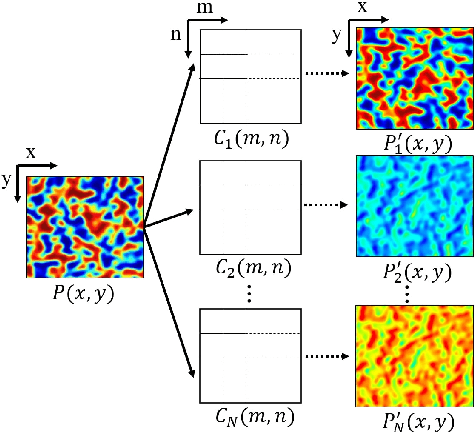
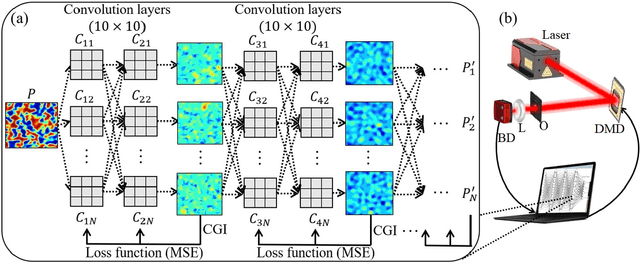
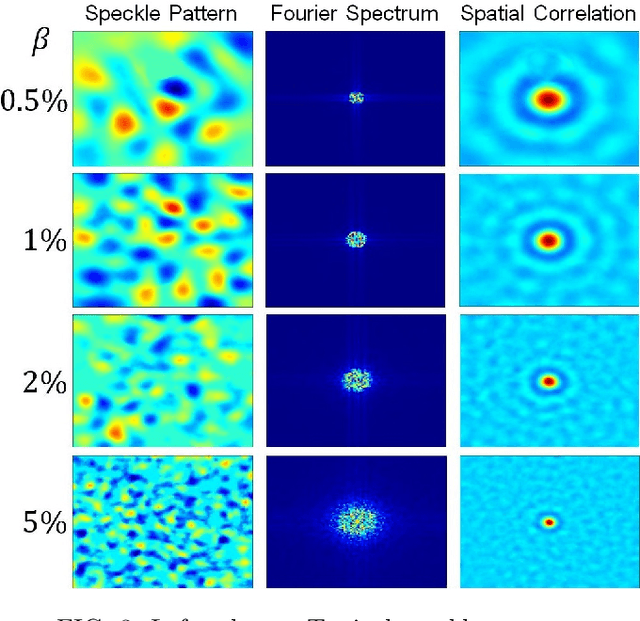
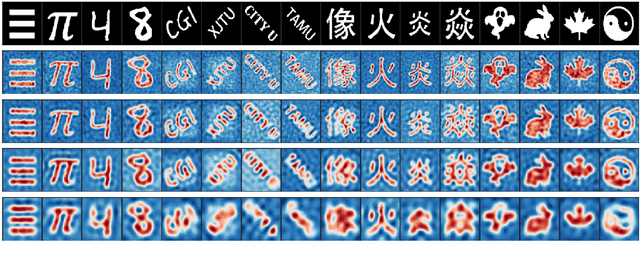
Abstract:In this paper, we present a method for speckle pattern design using deep learning. The speckle patterns possess unique features after experiencing convolutions in Speckle-Net, our well-designed framework for speckle pattern generation. We then apply our method to the computational ghost imaging system. The standard deep learning-assisted ghost imaging methods use the network to recognize the reconstructed objects or imaging algorithms. In contrast, this innovative application optimizes the illuminating speckle patterns via Speckle-Net with specific sampling ratios. Our method, therefore, outperforms the other techniques for ghost imaging, particularly its ability to retrieve high-quality images with extremely low sampling ratios. It opens a new route towards nontrivial speckle generation by referring to a standard loss function on specified objectives with the modified deep neural network. It also has great potential for applications in the fields of dynamic speckle illumination microscopy, structured illumination microscopy, x-ray imaging, photo-acoustic imaging, and optical lattices.
 Add to Chrome
Add to Chrome Add to Firefox
Add to Firefox Add to Edge
Add to Edge